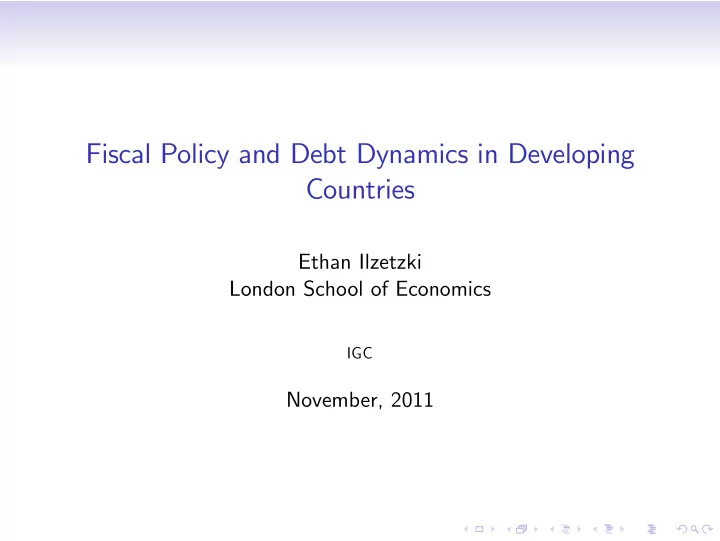

Fiscal Policy and Debt Dynamics in Developing Countries Ethan Ilzetzki London School of Economics IGC November, 2011
Ilzetzki, Mendoza and Vegh (2012) � Ilzetzki, Mendoza and Vegh (2012) evidence on the government purchases multiplier. � Rather small (0 to 0.4) in the short-run � Magnitude in the long run depends crucially on country characteristics � Degree of monetary accomodation � Openness to international trade � Sovereign debt � In developing countries importance of composition (consumption/investment).
Tax Cuts as Stimulus � During the recent downturn …scal stimulus utilized both sides of the government balance sheet � While debate has largely focused on government expenditure, � only half of the ARRA (US stimulus of 2009) was in the form of government purchases; � government purchases in the UK increased roughly along their (quadratic) trend of the Labour parliaments. � Tax revenues declined signi…cantly � Mainly due to an endogenous decline in the tax base � But also due to discretionary measures: � $288 billion in tax measures in the US, primarily personal income tax credit; some corporate tax incentives � VAT cut in the UK from 17.5% to 15%.
Importance of Debt � Have also ignored the dynamic aspect of debt accumulation. � Fiscal stimulus causes an increase in debt, which may have e¤ects on GDP. � Simple linear VAR may not account for this (may be along an unsustainable debt path).
Outline � Description of dataset � The growth impact of tax policy: panel analysis � SVAR analysis � Accounting for debt dynamics
Data � New comprehensive datset of marginal tax rates � 28 countries: 7 high-income, 21 developing � Calculated from tax codes taken from OECD and Pricewaterhouse Coopers
Econometric Model � PVAR, including GDP, government consumption, government expenditures � K ∑ AY n , t = C k Y n , t � k + Bu t , k , k = 1 � Identifying assumption: Blanchard and Perotti (2002) � (Excluding transfers) government expenditures cannot respond to innovations within a quarter � Tax elasticities estimated from institutional information.
Simple OLS/GMM Estimation � Regress GDP growth on (lagged) changes in past tax rates. � Following Barro and Redlick (2010) also include lagged unemployment rate. � Alternatively: Arellano-Bond GMM to address autocorrelation in GDP growth and (to some extent) reverse causation from GDP to tax rates.
Debt Dynamics K ∑ AY t = [ C k Y t � k + D k d t � k ] + Bu t , k = 1 Favero-Giavazzi: ( 1 + ∆ p t ) ( 1 + ∆ y t ) d t � 1 + exp g t � exp T t 1 + i t d t � , exp y t Ilzetzki: d t � ( 1 + i t ) [ δ ( 1 + ∆ s t ) + 1 � δ ] d t � 1 + exp g t � exp T t , ( 1 + ∆ p t ) ( 1 + ∆ y t ) exp y t
Why does sovereign debt matter? 1. Current …scal stimulus implies future …scal austerity. 2. Higher debt increases real interest rates. 3. Higher debt causes in‡ationary pressures. 4. Direct e¤ects of sovereign debt on GDP growth?
Why does sovereign debt matter? 1. Current …scal stimulus implies future …scal austerity. 2. Higher debt increases real interest rates. 3. Higher debt causes in‡ationary pressures. 4. Direct e¤ects of sovereign debt on GDP growth?
Research in progress 1. Debt dynamics in a panel of developing countries 1.1 Greater empirical power. 1.2 Non-linearities, regime switching. 2. Narrative approach to estimate e¤ects of taxes.
Recommend
More recommend